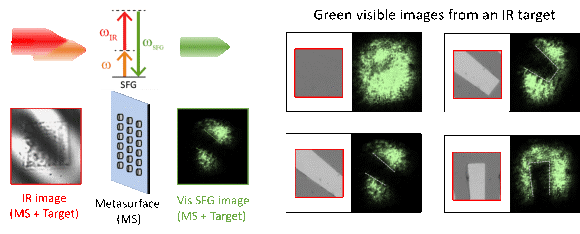Infrared imaging by ultra-thin nanocrystal layers
16 Jun, 2021
The demand for detecting infrared (IR) light, invisible to human eyes, is constantly growing, due to a wide variety of applications ranging from food quality control and remote sensing to night vision devices and light detection and ranging (LIDAR). Commercial IR cameras require the conversion of infrared light to electrons and the projection of the resultant image on a display. This display blocks the transmission of visible light, thereby disrupting normal vision. Moreover, such IR detectors require low temperature and even cryogenic cooling due to the low energies of the IR photons, making IR detectors bulky and heavy.
An all-optical alternative to traditional cameras is the use of a nonlinear optical process to convert IR light into visible. In this case, electrical signals are no longer involved in the IR detection process, and the image, converted to the visible, can be captured by eye or phone-type camera. The optical process employed in this technique is nonlinear sum-frequency generation (SFG). In the SFG process, two incident photons, one of them in the IR spectrum, interact within a nonlinear material to generate emission at higher and visible frequencies. However, in the usual approaches this conversion relies on bulky and expensive nonlinear crystals.
A very attractive platform to overcome these limitations is the use of ultra-thin nanocrystal layers, known as metasurfaces. Metasurfaces are planar arrays of densely packed nano-antennas, designed to manipulate various properties of the incident light including its frequency. Among various examples, dielectric and semiconductor metasurfaces have shown great promise to enhance nonlinear optical processes at the nanoscale. Such metasurfaces can exhibit enhanced frequency conversion due to the excitation of optical resonances and good coupling to free-space. Thus, the use of nonlinear metasurfaces is a promising way to up-convert IR photons to visible and thereby image IR objects through coherent conversion using ultra-thin and ultra-light devices. Importantly, transparent metasurfaces could perform IR imaging in a transmission configuration and simultaneously transmit visible light to allow for normal vision.
With this idea in mind, researchers from The Australian National University (ANU), Nottingham Trent University (NTU), and collaborators worldwide managed to demonstrate IR imaging via nonlinear metasurfaces composed of small semiconductor nanocrystals. As reported in Advanced Photonics, the researchers designed a multi-resonant metasurface to enhance the field at all the frequencies participating in the SFG process. The designed metasurface was fabricated and transferred to a transparent glass, forming a layer of nanocrystals on the glass surface.

The proposed metasurface-based IR imaging approach offers novel opportunities not possible in conventional up-conversion systems. For example, the use of counter-propagating excitation beams, as well as incidence at different angles and, most importantly, multi-colour IR imaging by an appropriately designed metasurface. Therefore, the results obtained by the researchers can benefit the future development of compact night vision instruments and sensor devices, offering an ultra-thin and ultra-compact platform and new functionalities such as multi-color IR imaging at room-temperature.
Header image credit: Lei Xu, Nottingham Trent University.
Infrared upconversion imaging in nonlinear metasurfaces
Maria del Rocio Camacho-Morales, Davide Rocco, Lei Xu, Valerio F. Gili, Nikolay Dimitrov, Lyubomir Stoyanov, Zhonghua Ma, Andrei Komar, Mykhaylo Lysevych, Fouad Karouta, Alexander A. Dreischuh, Hark Hoe H. Tan, Giuseppe Leo, Costantino De Angelis, Chennupati Jagadish, Andrey E. Miroshnichenko, Mohsen Rahmani, Dragomir N. Neshev
Advanced Photonics, 14th June 2021
Infrared imaging is a crucial technique in a multitude of applications, including night vision, autonomous vehicle navigation, optical tomography, and food quality control. Conventional infrared imaging technologies, however, require the use of materials such as narrow bandgap semiconductors, which are sensitive to thermal noise and often require cryogenic cooling. We demonstrate a compact all-optical alternative to perform infrared imaging in a metasurface composed of GaAs semiconductor nanoantennas, using a nonlinear wave-mixing process. We experimentally show the upconversion of short-wave infrared wavelengths via the coherent parametric process of sum-frequency generation. In this process, an infrared image of a target is mixed inside the metasurface with a strong pump beam, translating the image from the infrared to the visible in a nanoscale ultrathin imaging device. Our results open up new opportunities for the development of compact infrared imaging devices with applications in infrared vision and life sciences.